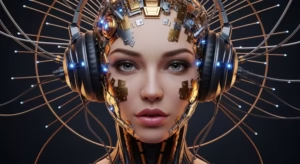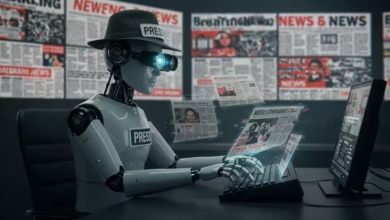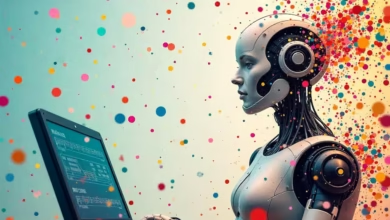Top 5 AI Video Generators You Can Use Today

This blog post explores the top 5 AI video generators available today, highlighting the best AI video generators that can transform text into captivating video content. It provides a comprehensive overview of text-to-video technology, showcasing how these innovative tools work. The article specifically analyzes the features of prominent platforms such as Runway ML and Pika Labs, comparing their functionalities and usability. Additionally, readers will find actionable tips for selecting the right AI video generator that suits their creative needs and budget. Whether you’re a marketer, content creator, or educator, this guide aims to help you harness the power of AI in video production.
Discover The Best AI Video Generators Available Today

In the rapidly evolving world of digital content creation, leveraging the best AI video generators has become essential for content creators AI. These tools not only enhance productivity but also allow creators to produce high-quality video content without requiring extensive technical skills. By utilizing advanced algorithms, these generators can transform scripts and ideas into engaging visual narratives, making them invaluable assets in today’s content landscape.
Top AI Video Generators:
- Runway ML – Known for its user-friendly interface and powerful editing tools.
- Pika Labs – Offers unique features for generating animation-based videos from scripts.
- DeepBrain – A robust option that excels in creating realistic avatars and human-like speech.
- InVideo – Perfect for quick video production with a wide range of templates.
- Animoto – Simple yet effective, ideal for adding a personal touch to promotional videos.
- Wave.video – Combines video editing with social media optimization tools.
- Synthesia – Focuses on AI avatars and video content localization.
Using these top tools, content creators AI can streamline their workflow and boost creativity. Each generator comes with distinct features tailored to various needs, from professional branding to entertaining social media posts. Ultimately, the choice of tool may depend on your specific objectives and the type of audience you aim to engage.
Comprehensive Overview Of Text To Video Technology

Text to video technology has revolutionized the way we create and consume digital content. By converting written text into engaging videos, this technology allows content creators to present information in a more dynamic format. The developments in AI video editing have made it easier for businesses and individuals alike to leverage this technology, ensuring that they can deliver captivating narratives that resonate with their audiences. As the landscape of digital media continues to evolve, understanding the mechanics behind text to video is essential for anyone looking to enhance their content strategy.
The process of turning text into video involves several stages, starting from the initial text input all the way through to the final edited video output. Each of these stages is critical in ensuring that the final product is not only informative but also visually appealing. The advent of AI tools has significantly streamlined this process, enabling rapid video production with minimal manual intervention. AI video generators are now widely used to automate various aspects of video creation, making it accessible for users with varying levels of expertise.
Key Steps In Text To Video Conversion:
- Input text: Begin with a clear script or text that you want to convert.
- Content analysis: Use AI technology to analyze the text for key themes and objectives.
- Visual element selection: Choose suitable images, video clips, or animations that align with the text.
- Audio integration: Add voiceover or background music to enhance the narrative.
- Editing: Utilize AI video editing tools to arrange visuals and audio in a harmonious flow.
- Preview and adjustments: Review the draft and make necessary adjustments for clarity and impact.
- Export: Finalize and export the video in the desired format ready for sharing across platforms.
As text to video technology progresses, it’s also crucial to consider its various applications across industries. From marketing and education to entertainment, the versatility of this technology means it can be tailored to fit different needs. For example, businesses use text to video to create promotional content, while educators may turn lectures into engaging visual aids. The capacity to produce rich, informative videos quickly has made this technology indispensable in a world that craves visual content.
Applications Of Text To Video
The applications of text to video technology are vast and varied, impacting both personal and professional spheres. Companies can utilize this technology for training purposes, allowing employees to absorb information more effectively through visual storytelling. Likewise, content creators are discovering that they can boost engagement on social media by converting blog posts and articles into engaging videos. This not only broadens their reach but also caters to a more visually-oriented audience. In a world dominated by sensory engagement, leveraging text to video tools can provide a significant competitive advantage.
Analyzing The Features Of Runway ML And Pika Labs
When exploring the best AI video generators, two platforms stand out for their unique capabilities: Runway ML and Pika Labs. Both tools cater to creators who aim to integrate AI into their video production processes, offering distinct features and user experiences. This analysis will delve into what each platform has to offer, guiding users to make informed choices based on their specific needs.
| Feature | Runway ML | Pika Labs |
|---|---|---|
| Ease of Use | User-friendly interface with drag-and-drop capabilities | Intuitive dashboard focused on fast video generation |
| AI Models | Offers diverse models for various applications | Specializes in character animation and storytelling |
| Collaboration Features | Strong support for team collaborations | Limited collaboration tools available |
| Output Quality | High-quality visuals, optimized for professional use | Good quality, but focuses more on speed over details |
Understanding the differences between Runway ML and Pika Labs is crucial for selecting the right tool. As both platforms evolve, they incorporate advanced technologies that cater to different user needs. For instance, Runway ML emphasizes user collaboration and professional output, making it suitable for businesses and creators aiming for high-quality results. In contrast, Pika Labs offers rapid video generation with a focus on creative storytelling, appealing to those looking for quick solutions.
Comparative Features:
- User interface and accessibility
- Variability of AI models available
- Quality and depth of video output
- Collaboration tools for team projects
- Learning curve for new users
- Pricing models and accessibility
Runway ML Vs. Pika Labs
In comparing Runway ML and Pika Labs, it’s essential to consider what you’re looking to achieve with an AI video generator. Runway ML is renowned for its versatility, serving a wide range of creative applications from video editing to special effects. Meanwhile, Pika Labs shines for its rapid output and ease of use, ideal for those new to AI technology or those seeking quick turnaround times for projects. Ultimately, the choice between these platforms hinges on specific project requirements and user preferences.
Actionable Tips To Choose The Right AI Video Generator
Choosing the right AI video generator can significantly impact the quality and effectiveness of your video content. With the increasing demand for highly engaging visuals, especially among content creators AI, it’s crucial to select a tool that meets your needs. Factors such as ease of use, template variety, and pricing options are key considerations for anyone looking to enhance their video production capabilities.
Considerations When Selecting An AI Video Tool:
- User-Friendliness: Look for software that offers an intuitive interface.
- Features: Assess the range of editing tools and effects available.
- Customization Options: Ensure you can personalize templates to fit your brand.
- Integration: Check if the tool integrates well with other software you use.
- Pricing: Compare subscription models to find the best value for your budget.
- Customer Support: Consider the level of support available for troubleshooting.
- Reviews and Feedback: Investigate user reviews to gauge satisfaction and reliability.
Taking the time to evaluate these elements will lead you to one of the best AI video generators suited for your specific requirements. Remember, your choice can enhance not just the aesthetics of your content but also the storytelling aspect, engaging your audience effectively and efficiently.
Briefing Document: The Future of AI Video Generation
Introduction
This briefing document synthesizes key information from the provided source, “Top 5 AI Video Generators You Can Use Today – The Future of Artificial Intelligence,” to offer a comprehensive overview of the current landscape of AI video generation. It highlights the main themes, important facts, and actionable insights for leveraging this transformative technology.
Main Themes and Key Insights
1. The Essential Role of AI Video Generators in Modern Content Creation
AI video generators are no longer a niche tool but have become “essential for content creators AI” in the rapidly evolving digital landscape. These tools significantly “enhance productivity” and enable the production of “high-quality video content without requiring extensive technical skills.” They are invaluable assets, capable of transforming “scripts and ideas into engaging visual narratives.”
2. Overview of Leading AI Video Generation Platforms
The market offers a variety of AI video generators, each with distinct features tailored to different needs. Key players highlighted include:
- Runway ML: Praised for its “user-friendly interface and powerful editing tools,” strong support for “team collaborations,” and output of “high-quality visuals, optimized for professional use.”
- Pika Labs: Offers “unique features for generating animation-based videos from scripts,” an “intuitive dashboard focused on fast video generation,” and specializes in “character animation and storytelling.” While its output quality is “Good quality, but focuses more on speed over details,” it’s ideal for quick solutions.
- DeepBrain: Excels in “creating realistic avatars and human-like speech.”
- InVideo: “Perfect for quick video production with a wide range of templates.”
- Animoto: “Simple yet effective, ideal for adding a personal touch to promotional videos.”
- Wave.video: “Combines video editing with social media optimization tools.”
- Synthesia: Focuses on “AI avatars and video content localization.”
The choice among these tools “may depend on your specific objectives and the type of audience you aim to engage.”
3. The Transformative Power of Text-to-Video Technology
Text-to-video technology is revolutionizing content creation by converting “written text into engaging videos,” making information more dynamic and accessible. This technology streamlines the video production process through several stages:
- Input text: Starting with a “clear script or text.”
- Content analysis: Using AI to analyze “text for key themes and objectives.”
- Visual element selection: Choosing “suitable images, video clips, or animations.”
- Audio integration: Adding “voiceover or background music.”
- Editing: Utilizing “AI video editing tools to arrange visuals and audio.”
- Preview and adjustments: Reviewing and refining the draft.
- Export: Finalizing and sharing the video.
The advent of AI tools has “significantly streamlined this process, enabling rapid video production with minimal manual intervention.”
4. Diverse Applications Across Industries
The applications of text-to-video technology are “vast and varied,” impacting both personal and professional spheres.
- Marketing: Businesses use it to “create promotional content” and “boost engagement on social media by converting blog posts and articles into engaging videos.”
- Education: Educators can “turn lectures into engaging visual aids,” helping employees “absorb information more effectively through visual storytelling” for training purposes.
- Entertainment: The technology can be tailored to “fit different needs” in this sector.
The capacity to “produce rich, informative videos quickly has made this technology indispensable in a world that craves visual content.”
5. Strategic Considerations for Choosing an AI Video Generator
Selecting the right AI video generator is crucial for content quality and effectiveness. Key considerations include:
- User-Friendliness: Prioritize “intuitive interface.”
- Features: Assess the “range of editing tools and effects available.”
- Customization Options: Ensure ability to “personalize templates to fit your brand.”
- Integration: Check compatibility with “other software you use.”
- Pricing: Compare “subscription models to find the best value.”
- Customer Support: Consider the “level of support available.”
- Reviews and Feedback: Investigate “user reviews to gauge satisfaction and reliability.”
The choice of tool can “enhance not just the aesthetics of your content but also the storytelling aspect, engaging your audience effectively and efficiently.”
AI video generators represent a significant leap forward in digital content creation, democratizing video production and opening new avenues for engaging audiences. By understanding the capabilities of various platforms and the strategic considerations for their selection, creators and businesses can harness this technology to produce high-quality, impactful video content with unprecedented efficiency.
For similar articles, please visit: AI in Art, Creativity & Media
Homepage / humanaifuture.com
🎧 Listen to the Podcast
Want to explore this topic in more depth? Listen to the full podcast for more insights and expert commentary.
▶️ Play on Google DriveNo sign-up needed — just click and listen.
How does "text-to-video" technology work, and what are its key stages?
Text-to-video technology revolutionizes content creation by converting written text into engaging videos. The process involves several key stages, starting with the Input text (a clear script or text). Next, Content analysis uses AI to identify key themes and objectives. This is followed by Visual element selection, where suitable images, video clips, or animations are chosen to align with the text. Audio integration adds voiceovers or background music, and then Editing uses AI tools to arrange visuals and audio harmoniously. Users then proceed to Preview and adjustments to refine the draft, before finally Exporting the video in the desired format for sharing.
What are some of the leading AI video generators available today, and what are their distinct features?
Some of the leading AI video generators include:
- Runway ML: Known for its user-friendly interface, powerful editing tools, and strong support for team collaborations, offering diverse AI models for various applications and high-quality professional output.
- Pika Labs: Offers unique features for generating animation-based videos from scripts, with an intuitive dashboard focused on fast video generation and creative storytelling.
- DeepBrain: Excels in creating realistic avatars and human-like speech.
- InVideo: Perfect for quick video production with a wide range of templates.
- Animoto: Simple yet effective, ideal for adding a personal touch to promotional videos.
- Wave.video: Combines video editing with social media optimization tools.
- Synthesia: Focuses on AI avatars and video content localization.
Each generator comes with distinct features tailored to various needs, from professional branding to entertaining social media posts.
How do Runway ML and Pika Labs compare as AI video generators?
Runway ML and Pika Labs are two prominent AI video generators, each with distinct strengths. Runway ML is highly versatile, emphasizing a user-friendly interface with drag-and-drop capabilities, diverse AI models, and strong support for team collaborations. It focuses on high-quality visuals optimized for professional use. In contrast, Pika Labs specializes in character animation and storytelling, offering an intuitive dashboard focused on fast video generation. While its output quality is good, it prioritizes speed over intricate detail and has more limited collaboration tools. The choice between them depends on whether a user prioritizes professional output and collaboration (Runway ML) or rapid creative storytelling (Pika Labs).
What are the diverse applications of text-to-video technology across different industries?
The applications of text-to-video technology are vast and varied, impacting both personal and professional spheres. In marketing and business, companies use it to create promotional content, training materials, and boost engagement on social media by converting blog posts and articles into engaging videos. Educators can transform lectures into engaging visual aids, allowing students to absorb information more effectively through visual storytelling. This technology is also used in entertainment and other fields, providing a significant competitive advantage in a world that increasingly craves visual content.
What factors should content creators consider when choosing an AI video generator?
Content creators should consider several key factors when selecting an AI video generator to ensure it meets their specific needs and enhances their video production capabilities. These considerations include:
- User-Friendliness: An intuitive interface for ease of use.
- Features: The range of editing tools and effects available.
- Customization Options: Ability to personalize templates to fit branding.
- Integration: Compatibility with other software used.
- Pricing: Comparison of subscription models for best value.
- Customer Support: The level of support available for troubleshooting.
- Reviews and Feedback: User reviews to gauge satisfaction and reliability.
Careful evaluation of these elements helps in selecting the most suitable tool.
How do AI video generators enhance productivity and creativity for content creators?
AI video generators significantly enhance productivity by automating various aspects of video creation, from analyzing text to selecting visual elements and integrating audio. This streamlines the workflow and enables rapid video production with minimal manual intervention. They boost creativity by allowing creators to focus on narrative and ideas rather than technical complexities, making high-quality video content accessible to users with varying levels of expertise. By transforming scripts and ideas into engaging visual narratives, these tools empower creators to produce dynamic content efficiently.
Why is understanding the mechanics behind text-to-video essential for a content strategy in today's digital media landscape?
Understanding the mechanics behind text-to-video technology is essential for a robust content strategy in today's evolving digital media landscape because it allows content creators to present information in a more dynamic and engaging format. As the world increasingly craves visual content, leveraging this technology ensures that businesses and individuals can deliver captivating narratives that resonate with their audiences. The capacity to produce rich, informative videos quickly and efficiently through AI tools provides a significant competitive advantage, broadening reach and catering to a more visually-oriented audience.




